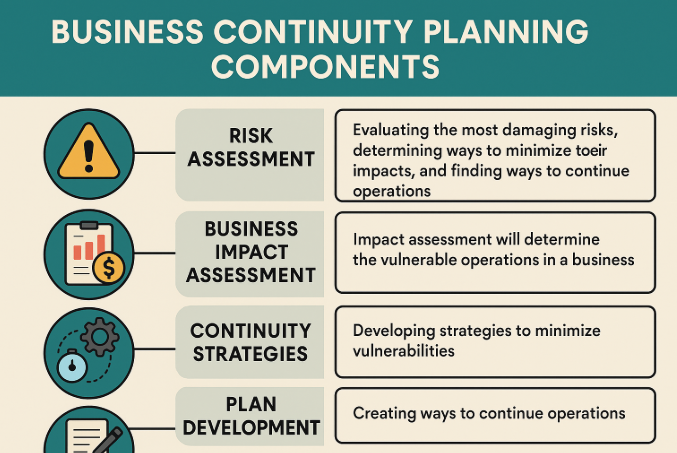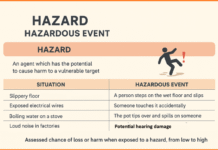In today’s uncertain world, emergencies….ranging from natural disasters and cyberattacks to pandemics and supply chain disruptions…..can strike without warning. Business Continuity Planning (BCP) ensures that organizations can continue critical operations, minimize downtime, and reduce revenue losses during and after such disruptions.
At its core, BCP involves evaluating the most damaging risks, determining how to reduce their impact, and developing strategies to maintain or quickly resume operations. Below are the essential components of an effective Business Continuity Plan.
Contents
1. Risk Assessment
The first step in BCP is to identify and assess potential threats that can disrupt business operations. These include:
- Natural disasters (earthquakes, floods)
- Technological failures (network outages, system crashes)
- Human threats (strikes, sabotage)
- Cyber incidents (data breaches, ransomware attacks)
- Pandemic or public health emergencies
Each risk is evaluated based on the likelihood of occurrence and its potential impact on the organization.
2. Business Impact Assessment (BIA)
The Business Impact Assessment identifies the critical operations and processes within an organization and determines the consequences if these operations are disrupted.
Key outcomes of a BIA include:
- Prioritized Business Functions – Pinpointing operations essential for survival.
- Vulnerability Analysis – Understanding which processes are most at risk.
- Recovery Time Objectives (RTO) – The maximum time allowed to restore a function.
- Recovery Point Objectives (RPO) – The acceptable amount of data loss measured in time.
The BIA forms the foundation for developing continuity strategies.
3. Continuity Strategies
Based on the findings from the risk and impact assessments, organizations develop strategies to mitigate threats and maintain operations. These may include:
- Alternative Worksites – Remote working or backup offices.
- Redundancies – Backup systems, duplicate data centers, secondary suppliers.
- Manual Workarounds – Temporary procedures for critical processes.
The goal is to build resilience and ensure seamless operations during disruptions.
4. Plan Development
This involves documenting all procedures and resources needed to maintain or restore operations. A complete continuity plan includes:
- Emergency contact lists
- Roles and responsibilities
- Step-by-step recovery procedures
- Communication plans
- Supply chain continuity plans
Every aspect of the plan must be clear, actionable, and easy to follow under stress.
5. Training and Awareness
A plan is only as effective as the people implementing it. Regular training ensures that staff:
- Understand their roles during an emergency.
- Know how to access and use the plan.
- Can respond effectively under pressure.
Awareness programs and mock drills reinforce preparedness and response capabilities.
6. Testing and Exercising
Regular testing uncovers gaps in the plan and ensures systems and people are ready to respond. Common types of exercises include:
- Tabletop exercises (discussion-based)
- Functional exercises (simulated operations)
- Full-scale drills (real-time scenario execution)
Post-exercise evaluations help refine and improve the plan.
7. Maintenance and Review
Business environments and risks evolve, making it essential to:
- Review the plan annually or after significant changes.
- Update contact details, technologies, and procedures.
- Learn from real events and drills to enhance effectiveness.
Continuity planning is not a one-time task but an ongoing process of improvement.
An effective Business Continuity Plan minimizes operational downtime and revenue loss by identifying vulnerabilities, planning mitigation strategies, and ensuring continued service delivery during disruptions. With a proactive BCP in place, organizations not only survive but also maintain stakeholder confidence and long-term viability.





